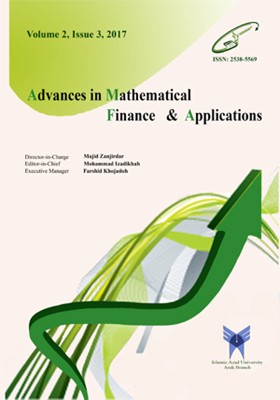American Option Pricing of Future Contracts in an Effort to Investigate Trading Strategies; Evidence from North Sea Oil Exchange
محورهای موضوعی : Financial EconomicsRamin Ahmadi 1 , Nahal Ariankia 2
1 - Department of Financial Engineering, Faculty of Technical Engineering, Khatam University, Tehran, Iran.
2 - Department of Financial Engineering, Faculty of Technical Engineering, Khatam University, Tehran, Iran.
کلید واژه: American future contract option, Optimal strategy of trader, Price difference of model and market,
چکیده مقاله :
In this paper, Black Scholes’s pricing model was developed to study American option on future contracts of Brent oil. The practical tests of the model show that market priced option contracts as future contracts less than what model did, which mostly represent option contracts with price rather than without price. Moreover, it suggests call option rather than put option. Using t hypothesis test, price differences were obtained, which can serve as a useful strategy for traders interested in arbitrage practice and risk hedging. This research introduces an optimal strategy (both for call and put option states and buy and sell of future contract ) for all options of buy and sell future contracts with and without price. In this research, six-month data of the end of 2015 about oil option and option of future contracts of North Sea oil for three different maturities were used.
[1] Agarwal, A. Juneja, S. Sircar, R., American options under stochastic volatility: Control variates maturity randomization & multiscale asymptotic, International Game Theory Review, 2015, 17(1), P. 154-170.
[2] Ball, C. Torous, W., Futures options and the volatility of futures price, Journal of finance, 1986, 41, P. 857-870.
[3] Bhargava, C., Pricing U.S. Dollar Index Futures Options: An Empirical Investigation, The financial Review, 2003, 38, P. 12-23.
[4] Balajewicz, M. Toivanen, J., Reduced order models for pricing american options under stochastic volatility and Jump-Diffusion models, The international conference on computational science, 2016, 80, P. 734-743.
[5] Ballestraa, L. Sgarrab, C., The evaluation of american options in a stochastic volatility model with jumps: An efficient finite element approach, Journal of computers and mathematics with applications, 2010, 60, P. 1571-1590.
[6] Clyman, D. Alen, C. Jaycobs, R., Liquidity without volume: The cost of FINNEX, Journal of futures markets, 1997, 17, P. 247-277.
[7] Hull, J., Fundamentals of futures and options markets, Toronto, University of Toronto, 2002.
[8] Ikonen, S. Toivanen, J., Operator splitting methods for American option pricing, International Journal of Rapid Publication, 2004, 17, P. 809-814.
[9] Longstaff, F. Schwartz, E.,Valuing american options by simulation: A simple least-squares approach, The review of financial studies, 2001, 4(1), P. 113-147.
[10] Lindstrom, F. Madsen, H. Nielsen, J., Statistics for Finance. New York, Taylor & Francis Group, 2015.
[11] Muzzioli, S. Reynaerts, H., American option pricing with imprecise risk-neutral probabilities. International Journal of Approximate Reasoning, 2007, 49, P. 140-147.
[12] Roman, J., Roll-Geske-Whaley Model, Analytical finance, Lecture notes AFI, 2010.
[13] Shastri, K. Tandon, K., An empirical test of a valuation model for American options on futures contracts, Journal of financial and quantitative analysis, 1986, 21(4), P. 377-392.
[14] Zhu, S. Chen, W., Pricing perpetual American options under a stochastic-volatility model with fast mean reversion, International Journal of Rapid Publication, 2011, 24, P. 1663-1669.


